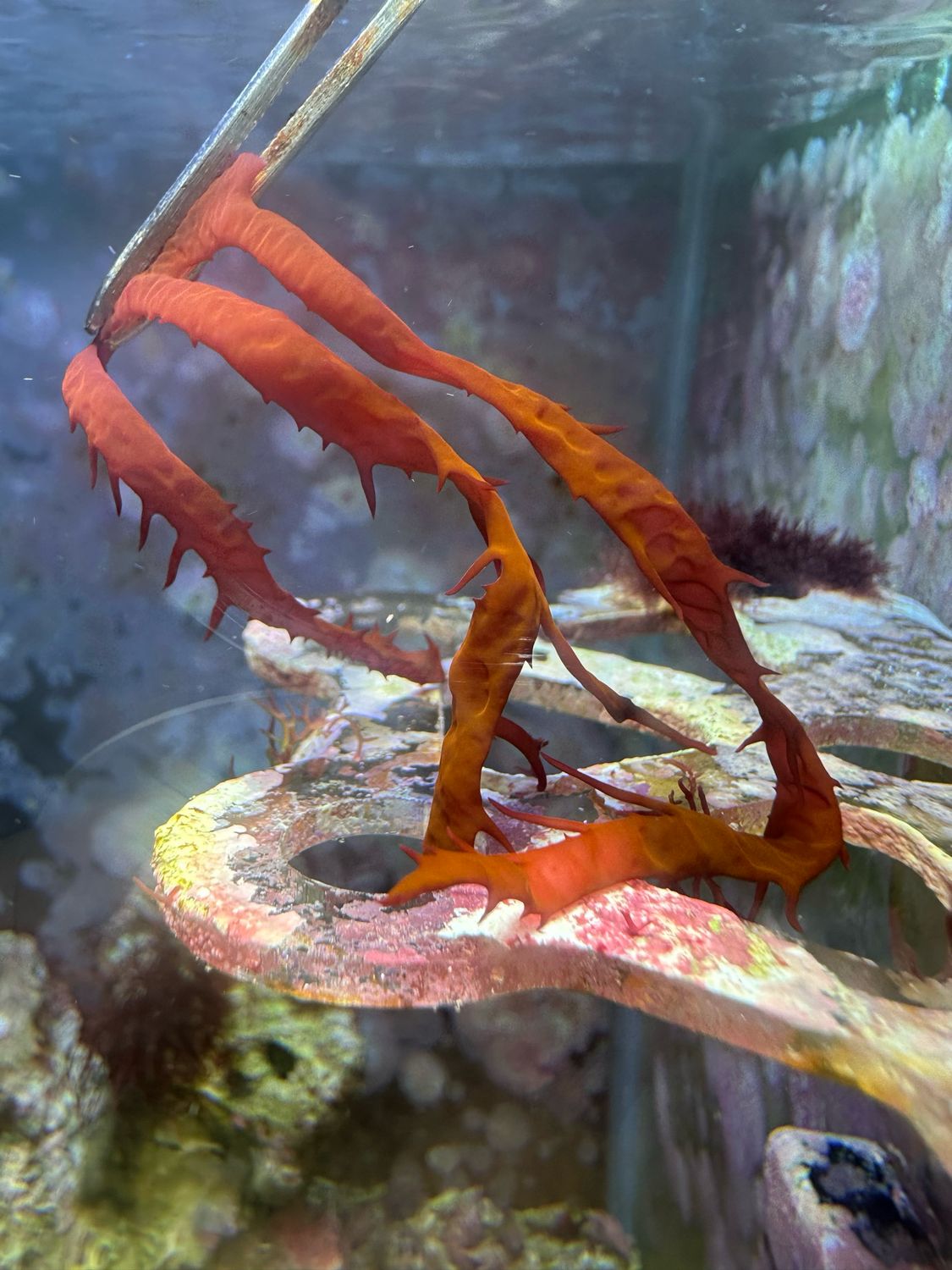‘Dragon’s Tongue’ Dragon’s Breath
‘Dragon’s Tongue’ will occasionally be out of stock as we need to grow the mother colony back out, but it will come back into stock again.
| Colour | Deep red |
| Fluorescence | Medium orange |
| Branching Pattern | Elongated, narrow branches |
| Thallus Shape | Flame-like |
| Surface Features | Smooth, delicate texture |
| Flexibility | Medium-High |
| Edge | Smooth |
‘Dragon's Tongue’ (Halymenia durvillei) is a unique variety of Halymenia that instantly captivates with its flame-like appearance, especially under aquarium lighting. With its elongated, narrow branches and pointed tips, this macroalgae resembles a Dragon's Tongue, radiating a fiery glow.
When fluorescing, ‘Dragon's Tongue’ lights up with a vivid orange, enhancing its flame-like look and making it a standout addition to any marine aquarium.
Nutrient Export
‘Dragon's Tongue’ not only provides visual interest but also plays an important role in maintaining water quality in your aquarium. This macroalgae effectively absorbs excess nitrates (NO₃⁻) and phosphates (PO₄³⁻) from the water, helping to control unwanted algae growth and keeping the environment healthy. Its steady growth rate makes it an excellent choice for both display tanks and refugiums, acting as a natural filter to enhance the health of your aquatic habitat.
Lighting
‘Dragon's Tongue’ thrives under moderate to bright lighting conditions, with a PAR (Photosynthetically Active Radiation) level between 100-150. Full-spectrum LED lighting or T5 fluorescent lights, especially those with a strong blue output, help accentuate its vibrant colours and unique fluorescent properties. Under these lights, ‘Dragon's Tongue’ will display ab orange fluorescence, giving it a dynamic, flame-like appearance.
Aim for a photoperiod of 8-10 hours per day to maintain its vibrant colours and support steady growth.
Nutrients
To keep ‘Dragon's Tongue’ healthy and growing, it requires a stable supply of nutrients. Maintain a minimum of 5 ppm nitrate (NO₃⁻) and 0.1 ppm phosphate (PO₄³⁻) in the water. Consistent, moderate nutrient levels will support its vibrant colours and growth. Regularly monitor nutrient levels to ensure they do not drop too low. If necessary, consider dosing a macroalgae growth mix, such as Continuum's Basis Chaeto Grow, to provide the trace elements and nutrients that keep it looking its best.
Placement and Attachment
‘Dragon's Tongue’ should be securely attached to rockwork or another stable surface in your aquarium to maintain its upright, flame-like appearance. Use a small amount of aquarium-safe superglue or a rubber band to gently secure it, or tuck it into a crack or crevice in your live rock, allowing it to naturally anchor over time. Position it in an area with moderate flow and light to encourage its characteristic shape and fluorescence.
Flow
‘Dragon's Tongue’ thrives in moderate water flow, which helps maintain its upright, flame-like structure while allowing for a gentle swaying motion that mimics a flame flickering in the wind. Avoid placing it in direct, high-flow areas, as this could damage its delicate fronds or cause it to detach. Find a spot where it can sway lightly, maintaining its unique appearance and effectiveness in nutrient export.
Care and Maintenance
‘Dragon's Tongue’ is relatively low-maintenance but will benefit from regular monitoring to keep it in peak condition. Check its growth periodically; if it begins to grow too large or crowd other areas of your tank, trim it back with clean, sharp scissors. This will help maintain its distinctive flame-like shape and encourage new growth. Watch for any signs of colour fading, which may indicate a need for adjustments in lighting or nutrients.
Compatibility
‘Dragon's Tongue’ is a peaceful addition to most marine aquariums, coexisting well with a variety of fish, corals, and invertebrates. However, be mindful of herbivorous species such as tangs, rabbitfish, sea hares, urchins, and certain snails (such as abalone), which may find its vibrant fronds appetising. If your tank contains herbivores, consider placing 'Dragon's Tongue' in a refugium, or a less accessible part of the tank to protect it from potential grazers.
Keep your reef raving and your macros waving!

